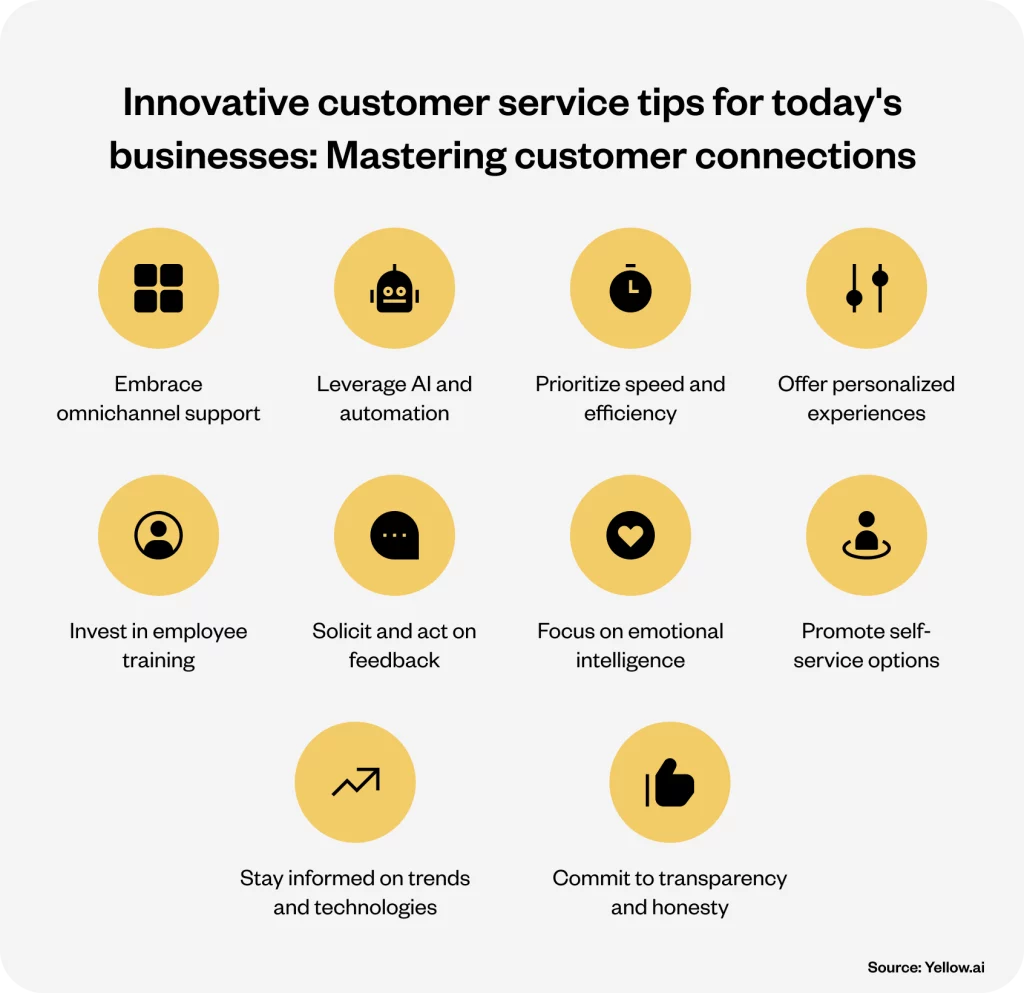Executive summary
Picture a world where every customer interaction is beyond just a transaction. Instead, it is a meaningful conversation. This blog will explore the intricacies of customer service, uncovering effective and innovative strategies that transform how businesses engage with their audience. We will guide you through a series of ‘customer service tips and tricks’ that are the blueprint for cultivating lasting customer relationships. Discover the power of good customer service tips in shaping memorable experiences, and learn how to apply these insights to your business, making every customer feel valued and understood.
Related must-reads:
- 10 Bad customer service examples (How to fix them)
- Customer service automation – A full guide
- 12 Customer service metrics to measure in 2024
- Should your business outsource customer service?
Introduction
Imagine a customer reaching out and their voice tinged with frustration. This moment, often seen as a challenge, is, in fact, a golden opportunity for businesses to shine. How you respond here can turn a potentially negative experience into a positive one, winning a loyal customer for life. With 90% of Americans considering customer service when deciding whether to do business with a company, the stakes are high. But fear not – the world of customer service is brimming with potential, and we’re here to unlock it for you.
Customer expectations are sky-high in today’s digital age. Research shows that 67% of customer churn could be avoided if businesses resolved issues during the first interaction. This statistic is a wake-up call for businesses to reevaluate and reinforce their customer service strategies. The vibrant landscape of customer service in 2024 is a world where a quick response can turn a critic into an advocate and where a well-placed word can build bridges.
This blog explains a variety of customer service tips and tricks, exploring the art and science of turning every customer interaction into an impactful, positive experience. Get ready to discover actionable insights and innovative strategies that will set your business apart in customer satisfaction and loyalty.
What are the three most important things in customer service?
Exceptional customer service remains a cornerstone of success in today’s competitive world. It goes beyond solving problems; it’s about fostering connections, understanding needs, and delivering experiences that leave a lasting impression. Let’s explore the three core elements that distinguish exceptional customer service:
1. Professionalism: Your steady compass
Professionalism in customer service uniquely defines your business. It is your anchor. It’s about delivering a consistent, high-quality experience, regardless of the challenges at hand. Whether a customer approaches you with excitement or frustration, the response they receive should be a reflection of your brand’s commitment to excellence.
Professional consistency is vital to building trust and establishing your brand as a dependable and respectful authority in your industry. It is about consistently showcasing your dedication to your customers’ needs.
2. Patience: The power of composed understanding
Patience is a strategic asset for any business in the customer service world. Each customer brings a unique set of expectations and challenges, and navigating these effectively requires patience and adaptability. Some issues are quick fixes, while others require a more nuanced and time-intensive approach.
The key is to approach each situation with an open mind and a willingness to understand and adapt. It is about genuinely investing time and effort to understand and resolve each customer’s concerns, ensuring that every solution is as individualized as the problem. This kind of patient, customized problem-solving builds a sense of loyalty and appreciation among your customers.
3. A people-first approach: Cultivating genuine connections
The most crucial part of effective customer service is a simple truth: customers crave understanding and connection. They seek more than just answers; they look for a human touch—a voice that resonates with empathy and sincerity.
Adopting a people-first approach means going beyond the transactional aspects of service. It’s about creating a dialogue where customers feel heard, valued, and understood. This approach could manifest in various ways, from a friendly tone in conversations to personalized follow-ups post-resolution. By putting people first, businesses transform customer support from a mere function to an experience, one that reflects compassion, understanding, and genuine care.
Related read: Customer service chatbots: Benefits and examples [2024]
Empowering your team: Dynamic customer service tips
Let us explore practical and insightful customer service tips, each uniquely designed to enhance the quality of customer service your business offers.

1. Embrace omnichannel support
Today’s customers hop seamlessly across various platforms. Hence, businesses must adopt an omnichannel approach. Omnichannel support means providing a seamless and consistent customer experience across all these platforms. Harvard Business Review found that customers who use multiple channels to interact with companies are more loyal.
To implement omnichannel support, integrate your communication channels so that information flows smoothly between them. It ensures that the customer service team has access to the entire history of a customer’s interactions, regardless of the platform used.
For instance, consider a retailer who integrates their CRM with social media platforms. When a customer who previously interacted on Facebook sends an email, the service agent instantly accesses this history, ensuring a continuous and personalized conversation. So, it’s not just about being present on all channels but about delivering a unified service experience.
Related reads:
- A guide on omnichannel customer engagement
- Omnichannel vs multichannel customer service – What is the difference?
- Seamless omnichannel CX: Your step-by-step guide
2. Leverage AI and automation
Utilizing Artificial Intelligence (AI) and automation in customer service can streamline operations and provide quick responses to common queries. AI chatbots capable of handling routine inquiries also free up human agents for complex tasks. However, it is more than just answering FAQs; AI can personalize interactions based on customer data, enhancing the experience.
Businesses can introduce AI-powered chatbots to handle routine inquiries, freeing up human agents for more complex issues. Always ensure these systems are integrated with your CRM to provide personalized responses.
Related read: AI Agent Assist – Elevating customer support efficiency
For example, a telecom company using AI can predict and suggest the best plans based on customer usage patterns. Another example is an AI chatbot that can efficiently handle basic tasks such as tracking an order or answering FAQs. At the same time, complex queries like negotiating a return are escalated to human agents. This mix of human and machine interaction can significantly enhance customer satisfaction.
Transform your customer service today with Yellow.ai

3. Prioritize speed and efficiency
Today’s customers expect quick resolutions. Implementing solutions like AI-powered ticketing systems can drastically reduce response times. But speed without accuracy can be counterproductive. According to Forrester, most customers believe that valuing their time is the most important thing a company can do to provide good service.
To implement this tip, optimize your customer service processes for speed. It could mean setting up quicker internal communication channels or using customer service software that allows for rapid response.
For example, a customer service team could use canned responses for common queries to speed up response times while ensuring personalized follow-ups for more detailed interactions. You may also consider Amazon’s customer service, renowned for quick and accurate responses, contributing significantly to customer satisfaction.
Related read: Customer experience vs customer service: More than just semantics
4. Offer personalized experiences
Personalization in customer service involves tailoring interactions to meet individual customer needs and preferences. It’s about creating a customer experience that feels tailor-made. A study by Epsilon found that 80% of customers are more likely to purchase from a brand that provides personalized experiences. You can use customer data to understand preferences and previous interactions. Train your team to recognize and respond to individual customer needs and histories.
Imagine a bookstore that recommends books based on past purchases or a streaming service like Netflix that curates content based on viewing history – these are prime examples of personalization in action.
5. Invest in employee training
The quality of your customer service is directly proportional to your team’s training. Well-trained customer service representatives are the backbone of excellent service. Regular training sessions keep your team updated with the latest trends and technologies. Furthermore, they also empower the employees with enhanced communication and problem-solving skills. To implement this tip, develop a comprehensive training program that includes product knowledge, communication skills, and empathy training.
Regular workshops and role-play scenarios can help your team prepare for a variety of customer interactions, ensuring they handle each situation with skill and confidence. Zappos, a company celebrated for its customer service, invests heavily in training its employees, creating a workforce that delivers exceptional customer experiences consistently.
6. Solicit and act on feedback
Customer feedback is invaluable for improving service. Encouraging customers to share their experiences and acting on this feedback can transform your service. Actively seeking and responding to feedback shows customers that their opinions are valued.
Use surveys, feedback forms, and social media listening tools to gather customer opinions. Act on this feedback to make tangible improvements. After resolving a customer issue, send a feedback survey. If multiple customers suggest longer support hours, consider extending your service time.
Starbucks exemplifies this approach with its ‘My Starbucks Idea’ platform, where customer suggestions are directly used to improve products and services, demonstrating a commitment to customer-driven innovation.
Related read: Customer sentiment analysis in 2024: How-to guide
7. Focus on emotional intelligence
Emotional intelligence in customer service is about understanding and responding to customers’ emotional states. It’s about training your team to empathize and connect on a human level. A study found that customers who feel they are understood and empathized with are more satisfied and loyal.
Train your team to recognize and respond to customers’ emotional cues. Encourage them to practice empathy and active listening. For example, consider a customer expressing frustration about a delayed order. Instead of just offering a refund, the service agent acknowledges the inconvenience caused and offers an additional discount on their next purchase as a gesture of goodwill.
8. Promote self-service options
Many customers prefer to find answers on their own, as they appreciate the empowerment of self-service. Providing self-service options can enhance customer experience and reduce the workload on your support team. An effective FAQ section or a well-designed interactive knowledge base can enhance the customer experience.
Create a user-friendly FAQ section on your website where customers can quickly find answers to common questions, reducing the need for direct contact with your support team. For instance, IKEA’s virtual assistant helps customers with assembly instructions, reducing the need for direct customer service interaction while ensuring customer satisfaction.
Related read: Self customer service: Navigating the new era of empowered consumers
9. Stay informed on trends and technologies
The customer service landscape is constantly evolving. Staying ahead in customer service means being aware of and integrating the latest trends and technologies. According to Accenture, 91% of consumers are more likely to shop with brands that provide relevant offers and recommendations. So, whether it’s adopting new communication platforms or integrating emerging AI capabilities, staying updated is crucial.
Regularly research and adopt new tools and practices that can enhance your customer service. Attend industry conferences and webinars and subscribe to relevant publications. For example, If there’s a rising trend in using messaging apps for customer service, consider integrating platforms like WhatsApp or Messenger into your customer service strategy.
Related must-reads:
- Top artificial intelligence (AI) trends for 2024
- Customer service trends to watch in 2024
- 10 key customer experience (CX) trends [2024]
10. Commit to transparency and honesty
Transparency builds trust. Being open about policies, capabilities, and limitations sets realistic expectations. A transparent approach to handling mistakes enhances customer trust and loyalty.
Ensure clear communication and admit mistakes when they happen. Provide honest product information and service expectations. For example, if there’s an issue with a product, proactively inform affected customers and offer a solution rather than waiting for them to contact you. This honest approach can turn a potentially negative situation into a positive experience of your brand’s integrity.
The two key ingredients to excellent customer service
Regarding customer service, two ingredients stand out as pivotal in cultivating a culture of excellence and understanding. These are empathy and prioritization. These elements of service strategy form the bedrock of meaningful customer interactions.
1. Empathy: The core of customer connection
Empathy in customer service isn’t just about responding; it’s about genuinely understanding and connecting with the customer’s feelings and perspectives. 92% of CEOs believe empathy is crucial to a company’s financial performance, emphasizing its importance in business success.
Genuine empathy involves active listening and responding in a way that shows customers you genuinely grasp their concerns. It’s about validating their feelings and offering solutions that demonstrate a deep understanding of their situation.
Consider a scenario where a customer, let’s call her Sarah, contacts your service team because she is upset about a product issue. Rather than offering a standard apology, your team member acknowledges her frustration, understands the issue’s impact on her, and takes immediate, personalized action to resolve it. It could be as simple as offering a prompt replacement or a special discount on her next purchase, showing that you value her experience and business.
2. Prioritization: Key to efficient customer service
In customer service, not all issues are created equal. Prioritization in customer service is about distinguishing urgent customer needs from less critical inquiries. It’s an essential skill for ensuring that significant issues receive the attention they deserve promptly.
Employing a system that categorizes customer issues based on urgency and impact is crucial. Use technology to flag urgent matters, such as service disruptions, while scheduling routine queries like general inquiries for later resolution.
Imagine running a tech support service. One morning, a flood of requests comes in. Among them is an urgent report of a significant software glitch affecting several key clients. Here, prioritization means focusing first on the software glitch while systematically addressing other less critical issues. This approach resolves the most pressing problem quickly and also manages customer expectations effectively for other service queries.
Empathy and prioritization are not just strategies; they are foundational pillars of excellent customer service. They enable businesses not only to meet but also exceed customer expectations, fostering loyalty and trust.
It leads us to the role of innovative solutions like Yellow.ai, which integrates these essential human elements with advanced AI and automation. Yellow.ai enhances the empathetic connection and optimizes issue prioritization, ensuring a customer service experience that is both effective and genuinely caring. Up next, let’s understand how Yellow.ai accomplishes this seamless blend of technology and human touch.
How Yellow.ai can help you automate your customer service team
When you think about delivering outstanding customer service, Yellow.ai is your ideal partner. It is a beacon of innovation, bridging the gap between human empathy and AI efficiency. Besides just automating the responses, Yellow.ai revolutionizes customer interactions with cutting-edge AI chatbots, a cornerstone of modern customer service.
Yellow.ai’s AI chatbots, powered by advanced algorithms and deep learning, offer a seamless integration of technological prowess and human-like understanding. These AI chatbots can understand, engage, and resolve customer issues, offering a personalized touch at every interaction. With features like Natural Language Processing (NLP) and context-sensitive responses, they provide solutions that are both efficient and empathetic.
Imagine an AI chatbot that goes beyond just resolving queries. It anticipates customer needs and offers proactive solutions and personalized recommendations. That’s the power Yellow.ai brings to your customer service team. It is a tool that enhances interactions, reduces resolution time, and improves overall customer satisfaction.
Intrigued by the potential of Yellow.ai’s AI chatbots in transforming your customer service?

The final thoughts
As we sum up this exploration of the customer service world, let’s pause to reflect. The various strategies, customer service tips, and insights can help enhance customer service and transform it into a memorable experience for both businesses and customers. It’s now clear that the future lies in a smart blend of human touch and technological innovation.
Let’s envision a future where every customer interaction is more than just a query resolved; it is a relationship strengthened. It’s about staying ahead of the curve, anticipating customer needs, and being ready to meet them with creativity, efficiency, and genuine care. That is the new paradigm of customer service excellence – a landscape where businesses succeed by genuinely connecting with their customers.
Frequently asked questions (FAQs)
What are the essential skills for great customer service?
The key skills for stellar customer service include active listening, empathy, problem-solving, patience, clear communication, and adaptability. Mastery in these areas ensures you can effectively understand, engage, and resolve customer issues while building solid relationships.
How can I handle difficult customers effectively?
Handling demanding customers involves staying calm, listening actively, empathizing with their situation, finding common ground, and offering clear, concise solutions. It’s crucial to remain professional and avoid taking things personally, focusing instead on resolving the issue at hand.
What are some helpful communication techniques for customer service interactions?
Effective communication techniques include using positive language, practicing active listening, clarifying and summarizing customer concerns, and providing clear, jargon-free explanations. Personalizing conversations and showing genuine interest also enhances the interaction.
How can I build rapport and trust with customers?
Build rapport and trust by being genuine, showing empathy, personalizing interactions, providing consistent and reliable service, and following up on previous interactions. Demonstrating an understanding of the customer’s needs and history with your business fosters deeper connections.
What are some best practices for dealing with customer inquiries through different channels (phone, email, chat)?
Best practices include responding promptly, maintaining a consistent tone and brand voice across all channels, personalizing responses, ensuring accuracy and clarity in communication, and leveraging the strengths of each channel for optimal engagement.
How can I utilize technology to improve my customer service performance?
Leverage technology by using CRM systems for personalized interactions, AI chatbots for handling routine queries, analytics tools for insights into customer behavior, and omnichannel platforms for seamless communication across various channels.
How can I continuously improve my customer service skills?
Continuously improve by seeking feedback, staying updated with the latest trends and technologies, engaging in regular training and skill development, analyzing performance metrics, and being open to adapting your approach based on customer needs and industry changes.





















